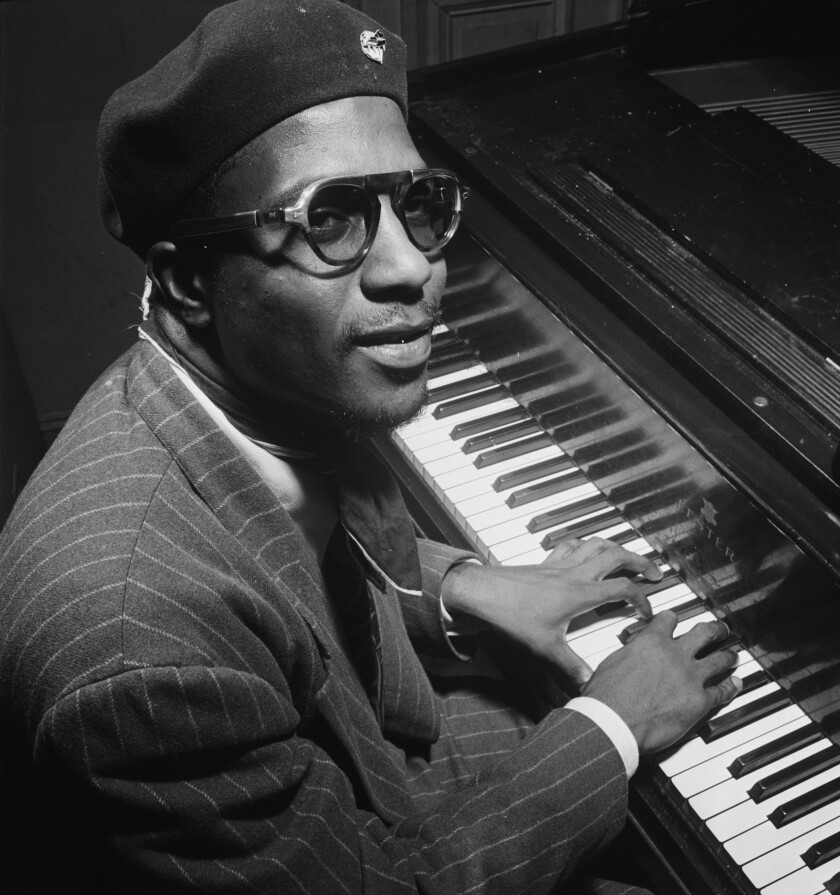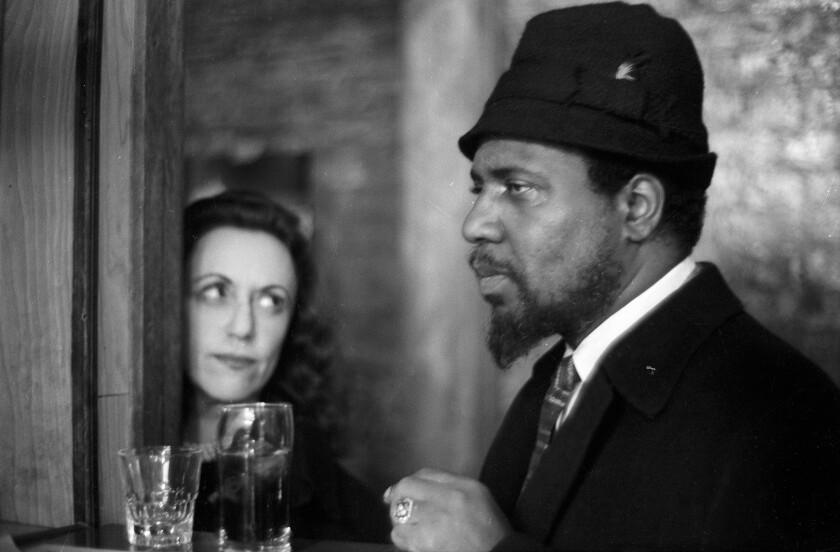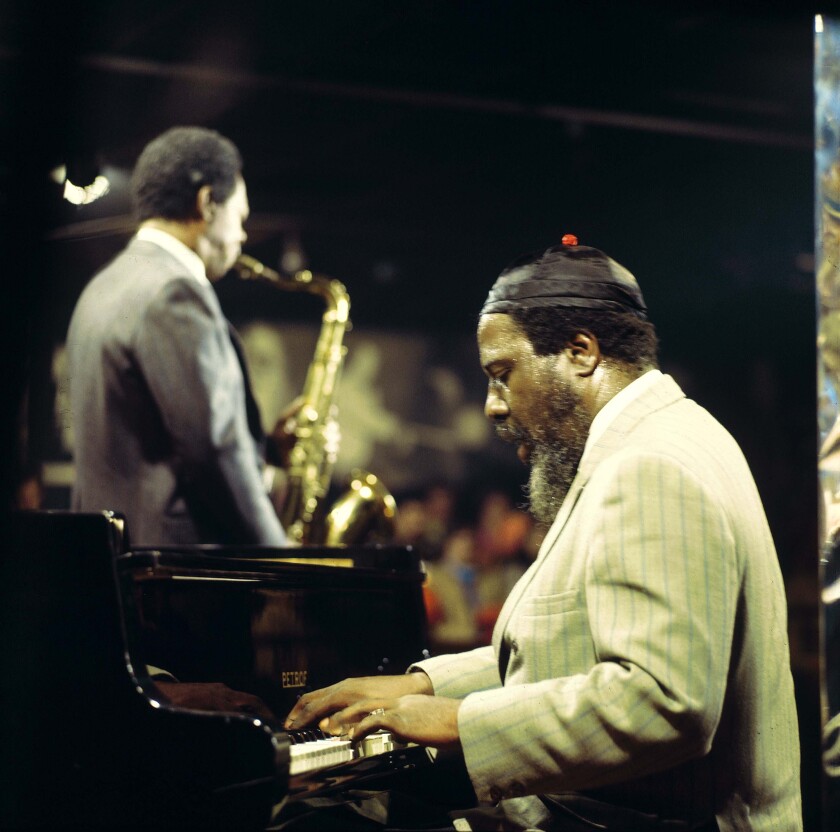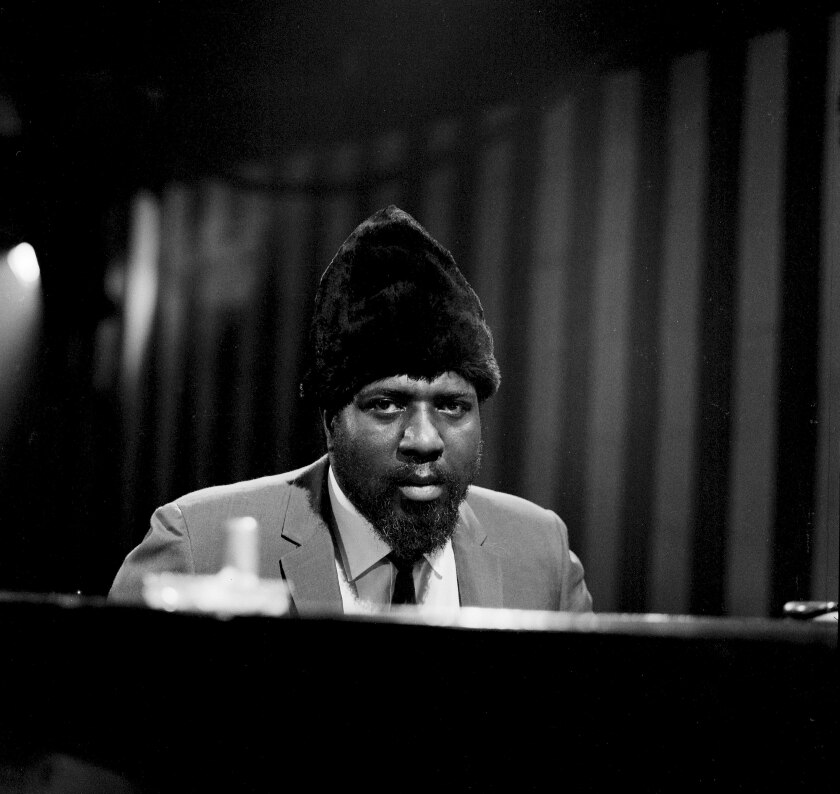[ad_1]
It appears purely coincidental that Thelonious Monk’s posthumous Pulitzer Prize for music in 2006 came only two years before Bob Dylan was awarded a Pulitzer of his own. But these two very different American music icons have more in common than first meets the eye or ear.
Monk is one of several jazz giants cited by name in the lyrics to Dylan’s epic 2020 song, the 17-minute-plus “Murder Most Foul.” In a subsequent interview with historian Douglas Brinkley, Dylan was asked to elaborate on his love for jazz and singled Monk out.
“Has any of it inspired me as a songwriter? Yeah, ‘Ruby, My Dear’ by Monk,” Dylan told Brinkley. “That song set me off in some direction to do something along those lines. I remember listening to that over and over.”
Dylan is not alone.
With the exceptions of Miles Davis and Charles Mingus, no other jazz giant of the 20th century continues to have as big an impact in and beyond jazz as Monk.
Indeed, it is difficult to think of another jazz artist whose music has been featured on albums by such disparate artists as Chaka Khan, Frank Zappa, Amy Winehouse, the Dirty Dozen Brass Band and Peter Frampton.
“Brilliant Corners,” to cite just one of Monk’s many indelible compositions, has been recorded by the Kronos Quartet, cutting-edge saxophonist Anthony Braxton and Rock & Roll Hall of Fame guitarist Andy Summers of The Police. Top jam band Phish has performed two other Monk gems, “Blue Monk” and “Jump Monk,” at its concerts.

Thelonious Monk is shown in the 1940s at Minton’s Playhouse in Harlem, where he helped launch the bebop revolution that turned jazz inside out.
(HUM Images / HUM Images/Universal Images Group via Getty Images)
Hip-hop and film
His appeal extends to hip-hop as well. Monk’s music has been sampled by Wu Tang Clan, Gang Starr, Jurassic Five and others. Avowed jazz fan Yasiin Bey (the rapper formerly known as Mos Def) will portray Monk in “Thelonious,” a biopic set to begin filming this summer.
At last count, more than 1,800 artists have recorded Monk’s luminous ballad, “ ‘Round Midnight,” which is also the title of a jazz-fueled 1986 feature film that won an Academy Award the following year. Monk is second only to Duke Ellington — one of his key inspirations — as the second-most recorded composer in jazz history.
“It’s impossible for someone to play or hear a Monk composition and not learn something,” said saxophone great Charles McPherson.
“There’s a multidimensional quality Monk has as a composer that speaks to all the elements of the human condition. That’s a quality Mingus and Stravinsky also have as composers.”
Equally revered as a singular composer, pianist and band leader, Monk’s legacy will be honored at Sunday night’s all-star concert, “Straight No Chaser: The Music of Thelonious Monk.” It is being held at The Rady Shell at Jacobs Park, the San Diego Symphony’s outdoor venue, which opened last year.
The performance will showcase some of Monk’s classic and lesser-known songs alike, each a marvel of soulful ingenuity. His best-known pieces — which include “Straight, No Chaser,” “Epistrophy,” “In Walked Bud,” “Well, You Needn’t” and “Evidence” — are as captivating as they are iconoclastic.
“All of Monk’s compositions are so unique and you can hear Monk’s solos in his compositions,” said top San Diego trumpeter Gilbert Castellanos, the symphony’s jazz curator and the founder of the Young Lions Jazz Conservatory.
Castellanos handpicked the musicians who will salute Monk at Sunday night’s concert at The Shell. In addition to him and saxophonist McPherson, the lineup includes acclaimed pianist Gerald Clayton, guitar ace Russell Malone, lithe bassist Rodney Whitaker and the superb drummer Lewis Nash.
“Charles and the other musicians are my heroes,” Castellanos said. “In a way, I’m being selfish by hiring them to bring Monk’s music to life in a whole new refreshing way.”
Each of Sunday night’s performers has selected favorite Monk compositions for the band to play in various configurations, from solo and duet numbers to trio, quartet, and full quintet pieces. In addition, the opening act — the national award-winning New Soil Ensemble — will also perform Monk pieces, with a youthful twist.

Thelonius Monk is shown backstage at New York’s Five Spot nighclub in 1963 with with arts patron Baroness Pannonica de Konigswarter, a famed supporter of jazz. He named his haunting ballad, “Pannonica,” in her honor.
(Ben Martin / Getty Images)
Multi-generational appeal
“All six of the members of New Soil are students at the Young Lions Jazz Conservatory. I asked each of them to write an arrangement of a Monk composition for this concert and I’m blown away by their arrangements,” Castellanos said.
“I make it a point to include at least one Monk composition, per class, per semester, in all the ensembles I teach. His music is part of the history of jazz that he contributed so much to. Monk has impacted me in so many ways, not only from a standpoint of improvising but also composing. And at our weekly Wednesday night Young Lions jam session at Panama 66 in Balboa Park last week, we played three Monk tunes.”
Just how broad Monk’s impact remains was demonstrated for Castellanos during a 2016 concert tour of Japan he did as a member of saxophonist Tom Scott’s band. After concluding a performance, they were invited to a late-night jazz jam session at a nearby club.
“Of course, I don’t speak Japanese and the majority of the Japanese musicians didn’t speak English,” the trumpeter recalled. “So, I said: ‘In Walked Bud.’ And they were all like, ‘Yes! Let’s play that!’ It was instant communication. Just say these Monk song titles, anywhere in the world, and people know them.”
More than the work of almost any other modern jazz pioneer, Monk’s music could be whimsical and graceful, elegant and elliptical, intricate and uncluttered, boisterous and suffused with a deeply resonant beauty.
As a pianist and as a composer, the North Carolina native favored twisting melodies and harmonies with deftly syncopated rhythms, unusual intervals, and a rare ability to make dissonance sound both appealing and essential. Simultaneously straightforward and quirky, his music was deceptively constructed in ways that challenged even the most adroit musicians.
Or, as sax legend John Coltrane — a member of Monk’s band in 1957 — once put it: “When you learn one of Monk’s pieces, you can’t just learn the melody and chord symbols. You have to learn the inner voicings and rhythms exactly. Everything is so carefully related; his works are jazz compositions in the sense that relatively few jazz ‘originals’ are.”
Along with Charlie Parker, Dizzy Gillespie, Bud Powell and Max Roach, Monk was considered a founding father of bebop, the revolutionary jazz style that ignited in the 1940s. But the path he charted was uniquely his own, even before Monk’s first recordings under his own name were released in 1947 on Blue Note.
‘Kids loved Monk’s music!’

Saxophonist Charlie Rouse and Thelonious Monk are shown performing on England’s “Jazz Scene” TV program in 1970. Rouse was one of Monk’s key musical foils and a good friend.
(David Redfern / Redferns)
He initially earned considerable attention for his angular melodies, unconventional harmonies, and quirky rhythmic accents. But no matter what he played, or how many unexpected turns his music took, many of Monk’s songs exude a playfulness that can make them as inviting to neophyte listeners of all ages as to longtime fans.
“Kids loved Monk’s music!’ ” longtime Monk saxophonist Charlie Rouse said in a July 1988 Union-Tribune interview.
McPherson readily agreed with that assessment.
“Most kids don’t know anything about melody or rhythm; they just know what they like,” McPherson said. “And some of Monk’s tunes, like ‘Trinkle, Tinkle’ and ‘Hackensack,’ have a delightful sense of humor kids can relate to.
“Because Monk’s music, in addition to being deep and thought-provoking, at times almost sound like they could be in a Walt Disney cartoon. Kids relate to that feeling of happiness and jauntiness.”
That Monk’s music could be jaunty and knotty was one of his trademarks. Their idiosyncratic nature made them stand out but did not obscure the depth of artistry he brought to his work, noted Rouse, who played in Ellington’s big band before teaming with Monk.
“Thelonious’ tunes are not the regular tunes you would play,” the saxophonist said in his 1988 Union-Tribune interview. “Sometimes he’d write a four-bar bridge, sometimes three-bars, and his phrasing was so different. You’d have to be flexible enough to listen and to blend with him, and then go ahead and express yourself.
“Because if you want to play Thelonious’ tunes your way, it won’t work out. You have to state his melodies the way he’s thinking, and then you can do whatever you want. He could draw things out of you that you would never think you can do. He’d challenge you.
“All the musicians — Dizzy, Sonny Rollins, John Coltrane — would tell you that he’s very inspirational. Thelonious reminds me of Duke Ellington as far as their musical approach and ability are concerned. To me, he and Duke are also very similar in the way they handled the men in their groups.”
Fellow saxophonist McPherson got to know Monk in New York, after moving there from Detroit in late 1959. They performed together once and he was greatly impressed by Monk, on stage and off.
“Everything about Monk was a curve ball!” McPherson said.
“I watched him play ping-pong with (pianist) Barry Harris, and Barry was pretty good. But Monk was really, really good. The way he served balls and returned them was just like how he played piano. He’d hit the ball with the paddle behind his back and still get it over the net or right on the corner.
“Every kind of screwball angle you could think of, he was able to contort himself and do it. The way he played ping-pong was totally consistent with his way of playing piano and composing. What you think is going to happen next in his music is not what happens next.”
In 1977, five years before his death, Monk was diagnosed with bipolar disorder and hypomania. Some observers believed the quirky nature of his music and the eccentric dances he sometimes did on stage reflected his condition.
Not so, said Rouse, his former saxophonist.
“He was warm and humorous,” the saxophonist said in his 1988 Union-Tribune interview. “And he was very warm and humorous in his music. He didn’t talk much, but he talked when he wanted to. And when he knew you well, you couldn’t get a word in!”
McPherson offered a more nuanced take.
“Monk was pretty enigmatic. At the same time — and with what we know now about him — his chemistry was different,” McPherson said.
“But it had nothing to do with his intelligence. Quite often, those kinds of people are quite brilliant and he was in that category. I was present once when somebody asked Monk: ‘How did you become so unique and such an individual in terms of your musical style?’
“Monk thought about it, and then he said: ‘Well, everybody has that. Everybody is a genius, and you are a genius. … The difference is that I have delved into who I am’.”

Thelonious Monk is shown performing in 1970 on “Jazz Scene,” a TV program in England.
(David Redfern / Redferns)
Thelonious Monk at a glance
Born: Oct. 10, 1917, in Rocky Mount, N.C.
First gigs: As a teenaged church organist in New York City, then on the road accompanying evangelist singers.
Breakthrough: As the house pianist at Minton’s Playhouse in Harlem, starting in 1940, he played alongside Charlie Parker, Dizzy Gillespie and other young lions who soon became the creators of bebop.
First big band: Monk became the pianist in the Lucky Millinder Orchestra in 1942.
First recordings: As a pianist for saxophonist Coleman Hawkins in 1944
First solo recordings: For Blue Note Records in 1947
First classic album: “Brilliant Corners” (1957)
Other standout albums: “Thelonious in Action” (1958); “Misterioso” and “The Thelonious Monk Orchestra at Town Hall” (1959); “Monk’s Dream” (1962); “Criss-Cross” (1963); “Straight, No Chaser” (1967); Underground” (1968).
Honors: Pulitzer Prize (2006); Grammy Lifetime Achievement Award (1993); the Thelonious Monk Institute of Jazz was founded in 1986, four years after his death.
Recommended reading: “Thelonious Monk: The Life and Times of an American Original” by Robin D.G. Kelley (Free Press)
Did you know?
Thelonious Monk is one of only five jazz artists to appear on the cover of Time magazine. Here is the full list.
- Louis Armstrong (1949)
- Dave Brubeck (1954)
- Duke Ellington (1956)
- Thelonious Monk (1964)
- Wynton Marsalis (1990)
“Straight No Chaser: The Music of Thelonious Monk”
With: Charles McPherson, Gilbert Castellanos, Gerald Clayton, Russell Malone, Rodney Whitaker and Lewis Nash, with the New Soil Ensemble
When: 6:15 p.m. Sunday
Where: The Rady Shell at Jacobs Park, 222 Marina Park Way, downtown
Tickets: $20-$75
Phone: (619) 235-0804
Online: theshell.org
[ad_2]
Source link
